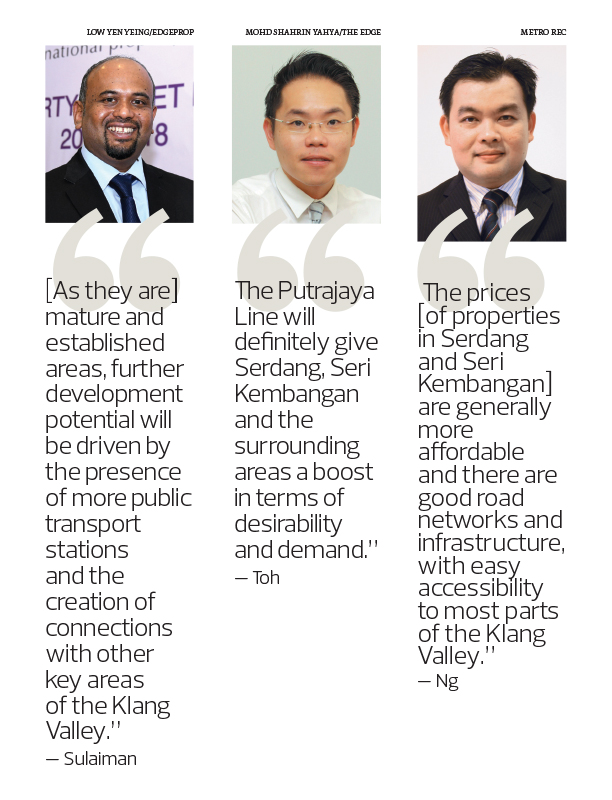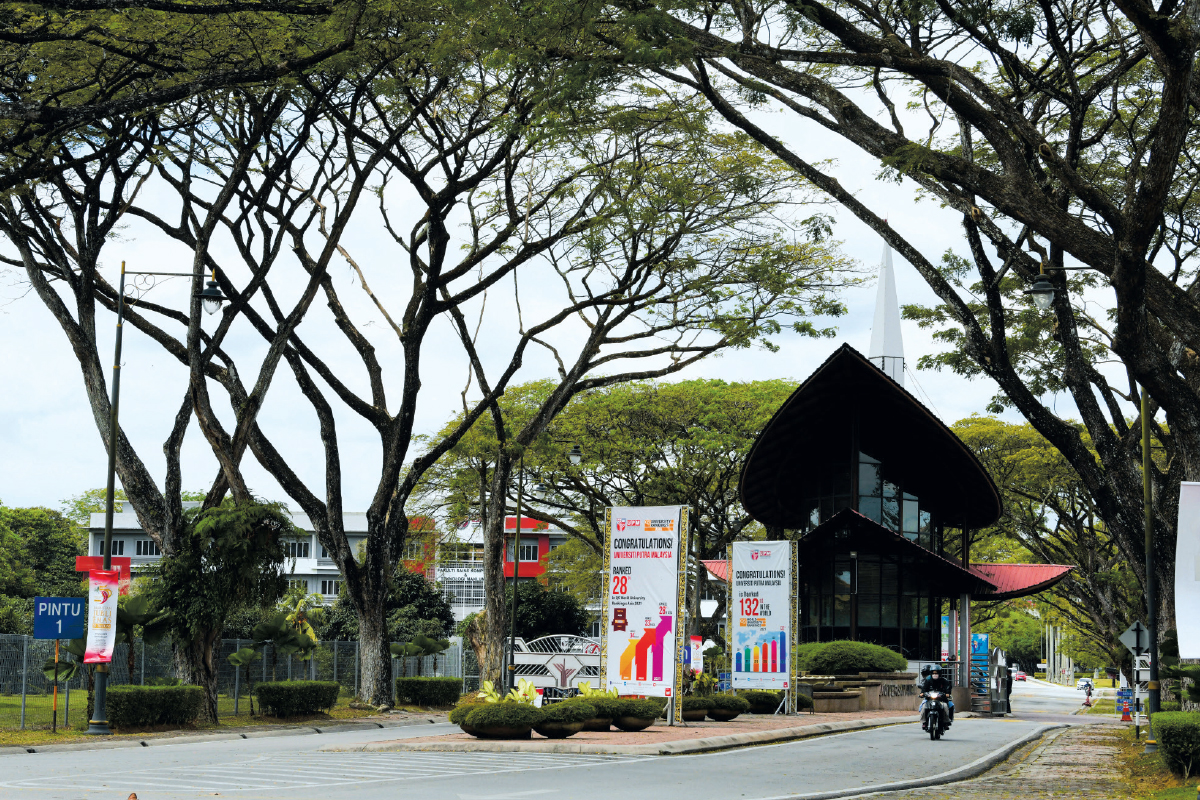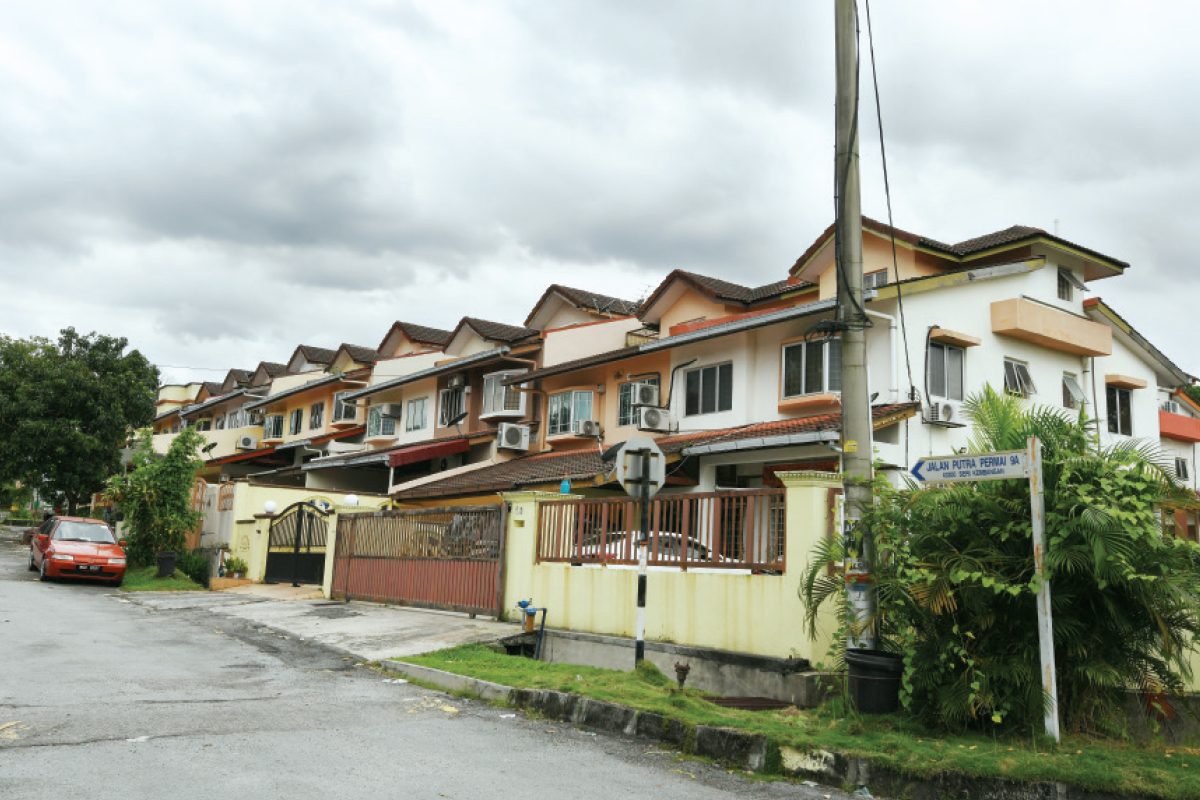
This article first appeared in City & Country, The Edge Malaysia Weekly on January 18, 2021 - January 24, 2021
The mantra of many property investors and developers has long been “follow the infrastructure”, and a large number of them have reaped the benefits. In Part 5 of our Special MRT2 coverage, City & Country takes a look at Serdang and Seri Kembangan, which will have stations along the upcoming Putrajaya Line — the second line of the Klang Valley mass rapid transit (MRT) project.
Previously known as the Sungai Buloh-Serdang-Putrajaya Line, Phase 1 of the Putrajaya Line — from the Kwasa Damansara station to the Kampung Batu station — is due to start operations in July. The rest of the line, from the Kampung Batu station to the Putrajaya Sentral station, will commence operations in January 2023.
Serdang and Seri Kembangan will have six stations in total, namely Serdang Raya North, Serdang Raya South, Serdang Jaya, UPM, Taman Equine and Putra Permai, while Puchong will have the 16 Sierra station.
“The Putrajaya Line will definitely give Serdang, Seri Kembangan and the surrounding areas a boost in terms of desirability and demand. The market and rental values will see an increase, particularly for projects with direct access to the stations,” says Laurelcap Group executive director Stanley Toh.
Rahim & Co International director of research and strategic planning Sulaiman Saheh believes that the new MRT line will further open up the areas and bring more people to these locations. “Those who use public transport have been relying primarily on the KTM Komuter Rawang-Seremban line as the main mass rail transport. However, the north and east of Puchong are now being serviced by the Sri Petaling LRT line. The southern part, which was lacking in rail line coverage, will be covered by two stations [under MRT2] albeit at some distance away,” says Sulaiman.
According to Metro REC Sdn Bhd managing director Ng Weng Yew, five of the six stations will be located adjacent to the Sungai Besi toll plaza along the KL-Seremban Expressway (Serdang Raya North station), Vision Home Expo in Seri Kembangan (Serdang Raya South station), Seri Kembangan fire station (Serdang Jaya [formerly known as Seri Kembangan] station), Pasar Borong Selangor (Taman Equine station) and The Atmosphere commercial centre (Putra Permai station).
Meanwhile, the UPM station will be located close to Universiti Putra Malaysia’s University Housing Complex (formerly known as the International Transit House) and agriculture field 2 of the Faculty of Agriculture. The 16 Sierra station is adjacent to IOI Properties Group’s development 16 Sierra.
“There will likely be an increase in demand [for properties] in neighbourhoods that are within a short distance of the aforementioned stations as public transport is still a major consideration for property buyers in the Klang Valley, especially in the suburbs,” says Ng.
Urbanised suburbs
Seri Kembangan was established by the British in the 1950s, says Ng. “Chinese villagers living in Sungai Besi were relocated to the area, which was formerly known as Serdang New Village. Now, it is home to a largely middle-income group, except for the new village and flats in Bukit Serdang and Pinggiran Putra, which has a lower-income population.”
Sulaiman notes that the population comprises mainly locals, and though some parts of Puchong have a largely Chinese community, the areas’ overall population is quite racially diverse.
Toh says, “The demographics there are mainly newly married couples, young families just starting out in the city, migrants from other states, and locals who grew up in the area. There is also a huge student population owing to the number of educational institutions such as UPM, Asia Pacific University of Technology & Innovation, Perdana University and SEGi College.”
Seri Kembangan and Serdang have been densely populated for many years. Sulaiman attributes their popularity to their location and rate of urbanisation. “For homebuyers looking for more urbanised areas with mixed-use developments outside of the Kuala Lumpur central region, these locations fit the bill. They have residential, commercial and even industrial components.
“Being located between Kuala Lumpur city centre and Putrajaya and Cyberjaya also contributes to their attractiveness as a residential area within a commutable distance. Commuting will be made easier with the commencement of the Putrajaya Line.”
Ng notes that there ia an ample choice of landed schemes in these locations and a sustainable rental market, particularly owing to the student population. “Properties in these areas offer value for money. The prices are generally more affordable and there are good road networks and infrastructure, with easy accessibility to most parts of the Klang Valley.”
Toh concurs with Ng, noting that before the announcement of the Putrajaya Line, affordability, space and a good road network played a part in boosting the areas’ popularity. At the same time, investors were mainly drawn to the huge student population.
“For investors, the Putrajaya Line will widen the renters’ market as people will be able to commute by rail,” says Sulaiman.
Among the wide range of amenities in the area are Pasar Borong Selangor, Hospital Serdang, AEON Equine Park, Giant Hypermarket Seri Kembangan, Selangor Turf Club, South City Plaza and Mines Wellness City. Major retail malls that are within 10km to 15km include IOI City Mall and Pavilion Bukit Jalil.
“There are several commercial hubs in the neighbourhoods such as Taman Equine, Pusat Perdagangan Seri Kembangan, TTDI Dualis Equine Park, Olive Hill Business Park and The Atmosphere,” says Ng. “The potential for price appreciation arising from proximity to neighbouring Bukit Jalil and Puchong, which command higher house prices and rentals, is also drawing house seekers.”
Based on data from Metro REC, a 2-storey terraced house with an average land area of 1,400 sq ft in Taman Bukit Serdang was transacted at RM700,000 in 2019, up from RM550,000 in 2015. In Taman Putra Permai, a similar house with a land area of 1,540 sq ft was transacted at RM600,000 in 2019, up from RM480,000 in 2015. Meanwhile, a 2-storey terraced factory in Bukit Serdang Light Industrial Park with a built-up of 3,800 sq ft was sold for RM1.7 million, up from RM1.5 million in 2015.
According to Toh, the average price of serviced apartments in Seri Kembangan is between RM250 and RM550 psf, while rental rates are from RM1.50 to RM2.50 psf, with yields of 5.5% to 6.5% per annum.
“The rate of return is driven mainly by students from nearby universities. However, from our database, the values have dipped by 10% to 20% over the last five years. In my opinion, the main contributing factors are traffic congestion and the infrastructure construction works, which have caused flash floods and unpleasantness in the areas,” opines Toh.
However, he says, “Although values have been moving downwards, they have mainly been dragged down by the older development schemes. The newer projects seem to be seeing value growth.”
There are several ongoing and upcoming projects in the area, including Eksons Corp’s Affiniti Residences, comprising 93 villas (minimum built-up of 3,300 sq ft) with a price tag of RM1.45 million and above, says Ng.
“Villamas Sdn Bhd is developing a 12-acre transit-oriented mixed-use development called meta_city. The project comprises two towers of small office/home office (SoHo) and serviced apartment units, one tower called Branded Suite, one office/hotel tower and a mall at the podium. The SoHos were priced at RM280,000 onwards during launch, while the serviced apartments are priced from RM480,000,” he adds.
Meanwhile, Beverly Group’s Equine Residence comprises three blocks of 861 SoHo/serviced apartments with a selling price of RM280,000 onwards (RM437 to RM661 psf).
Over at Taman Sungai Besi Indah, V Development Sdn Bhd is developing Mines Villa, which comprises 3-storey bungalows and link bungalows (3,992 to 4,790 sq ft) with a selling price of RM2.33 million onwards, says Sulaiman.
There is also Phase 2 of Elegan Residensi in Taman Putra Perdana by Gadang Land Sdn Bhd. It offers 134 units of 1½-storey townhouses with built-ups of 1,282 to 1,511 sq ft. Prices start from RM531,000.
According to Toh, other high-rise residential developments include Zenopy Residences by LBS Bina (RM409 to RM442 psf); Dream City by Clearwater Group (RM625 psf); Milenia Residence by Alaf Cahaya Development Sdn Bhd (RM450 to RM500 psf); and Galleria I & II by Global Oriental Bhd (RM530 psf).
Still going strong
According to Sulaiman, despite the availability of public transport, there continues to be a lack of connection between the stations and homes. There may even be an increase in traffic obstructions should there be insufficient parking spaces at the stations.
“Trains stations must have feeder buses that connect different residential and commercial spots. This would encourage residents and visitors to reduce the use of private vehicles, which would consequently reduce traffic congestion — a problem during peak hours,” he opines.
Ng says, “Traffic congestion during peak hours has increased substantially over the past two decades, in particular along the main thoroughfare of Jalan Besar-Jalan Putra Permai, which connects Taman Serdang Raya and 16 Sierra.”
Traffic congestion is not the only issue. The construction of the Putrajaya Line has caused flash floods and potholes, says Toh. “How can they be resolved? Perhaps the local council has to ensure that the maintenance works on public roads and spaces — and the contractors involved in the works — are up to the mark.”
According to Ng, low-lying areas in Seri Kembangan and Serdang often flood when the nearby Sungai Kuyoh overflows. “Flood mitigation and the upgrading of Sungai Kuyoh are necessary to solve this issue.”
Despite this, the property experts are optimistic about Seri Kembangan’s and Serdang’s future and the impact of the Putrajaya Line.
“[As they are] mature and established areas, further development potential will be driven by the presence of more public transport stations and the creation of connections with other key areas of the Klang Valley,” says Sulaiman. “With better options and access to more public transport routes, there would be hope of reducing the level of congestion, which is a normal occurrence in highly urbanised areas. This is important as the increasing number of high-rise developments will bring a sizeable number of residents to the areas.”
Ng remains positive about Seri Kembangan’s and Serdang’s growth in the long term, given their connectivity and general market demand.
“At present, the Maju Expressway that links to KL city as well as Kuala Lumpur International Airport has been a boon to the areas. Coupled with the Putrajaya Line, they will be sought-after locations in the near future,” says Toh.
Save by subscribing to us for your print and/or digital copy.
P/S: The Edge is also available on Apple's App Store and Android's Google Play.





